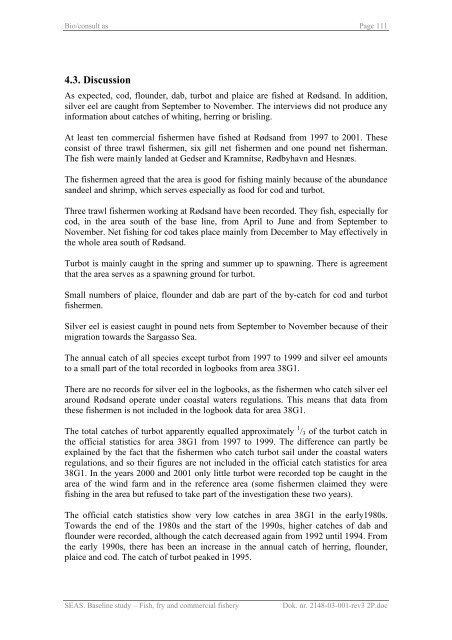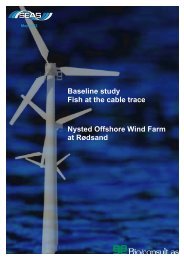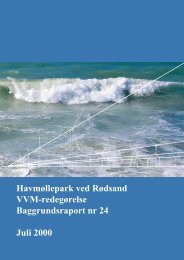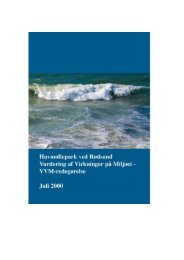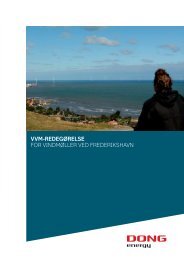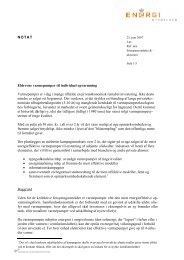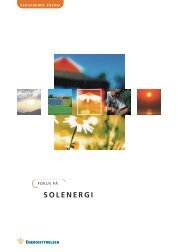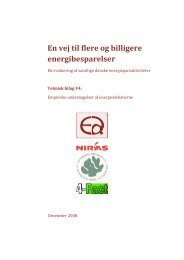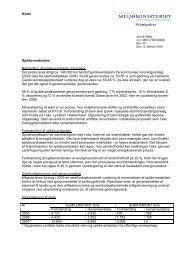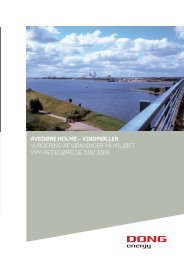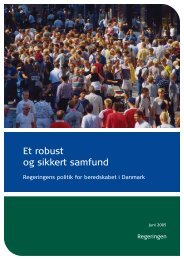Baseline study Fish, fry and commercial fishery Nysted Offshore ...
Baseline study Fish, fry and commercial fishery Nysted Offshore ...
Baseline study Fish, fry and commercial fishery Nysted Offshore ...
Create successful ePaper yourself
Turn your PDF publications into a flip-book with our unique Google optimized e-Paper software.
Bio/consult as Page 111<br />
4.3. Discussion<br />
As expected, cod, flounder, dab, turbot <strong>and</strong> plaice are fished at Røds<strong>and</strong>. In addition,<br />
silver eel are caught from September to November. The interviews did not produce any<br />
information about catches of whiting, herring or brisling.<br />
At least ten <strong>commercial</strong> fishermen have fished at Røds<strong>and</strong> from 1997 to 2001. These<br />
consist of three trawl fishermen, six gill net fishermen <strong>and</strong> one pound net fisherman.<br />
The fish were mainly l<strong>and</strong>ed at Gedser <strong>and</strong> Kramnitse, Rødbyhavn <strong>and</strong> Hesnæs.<br />
The fishermen agreed that the area is good for fishing mainly because of the abundance<br />
s<strong>and</strong>eel <strong>and</strong> shrimp, which serves especially as food for cod <strong>and</strong> turbot.<br />
Three trawl fishermen working at Røds<strong>and</strong> have been recorded. They fish, especially for<br />
cod, in the area south of the base line, from April to June <strong>and</strong> from September to<br />
November. Net fishing for cod takes place mainly from December to May effectively in<br />
the whole area south of Røds<strong>and</strong>.<br />
Turbot is mainly caught in the spring <strong>and</strong> summer up to spawning. There is agreement<br />
that the area serves as a spawning ground for turbot.<br />
Small numbers of plaice, flounder <strong>and</strong> dab are part of the by-catch for cod <strong>and</strong> turbot<br />
fishermen.<br />
Silver eel is easiest caught in pound nets from September to November because of their<br />
migration towards the Sargasso Sea.<br />
The annual catch of all species except turbot from 1997 to 1999 <strong>and</strong> silver eel amounts<br />
to a small part of the total recorded in logbooks from area 38G1.<br />
There are no records for silver eel in the logbooks, as the fishermen who catch silver eel<br />
around Røds<strong>and</strong> operate under coastal waters regulations. This means that data from<br />
these fishermen is not included in the logbook data for area 38G1.<br />
The total catches of turbot apparently equalled approximately 1 /3 of the turbot catch in<br />
the official statistics for area 38G1 from 1997 to 1999. The difference can partly be<br />
explained by the fact that the fishermen who catch turbot sail under the coastal waters<br />
regulations, <strong>and</strong> so their figures are not included in the official catch statistics for area<br />
38G1. In the years 2000 <strong>and</strong> 2001 only little turbot were recorded top be caught in the<br />
area of the wind farm <strong>and</strong> in the reference area (some fishermen claimed they were<br />
fishing in the area but refused to take part of the investigation these two years).<br />
The official catch statistics show very low catches in area 38G1 in the early1980s.<br />
Towards the end of the 1980s <strong>and</strong> the start of the 1990s, higher catches of dab <strong>and</strong><br />
flounder were recorded, although the catch decreased again from 1992 until 1994. From<br />
the early 1990s, there has been an increase in the annual catch of herring, flounder,<br />
plaice <strong>and</strong> cod. The catch of turbot peaked in 1995.<br />
SEAS. <strong>Baseline</strong> <strong>study</strong> – <strong>Fish</strong>, <strong>fry</strong> <strong>and</strong> <strong>commercial</strong> <strong>fishery</strong> Dok. nr. 2148-03-001-rev3 2P.doc


